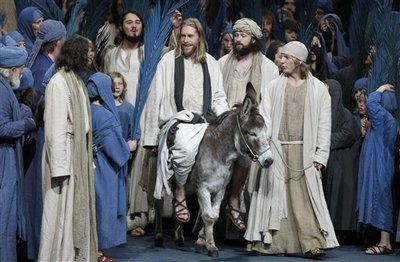
One of the world’s most famous — and controversial — theater pieces is opening once again, and garnering even more attention than usual:
Time advances slowly in this Alpine village, measured in decade-long spans between performances of Oberammergau’s nearly 400-year-old enactment of the suffering and crucifixion of Jesus Christ.
Changes to the ritual, started in 1633 as a promise to God by the village’s Roman Catholic populace in exchange for calling off the plague, are always hotly debated.
In this year’s edition, director Christian Stueckl — who normally directs at Munich’s Volkstheater — has altered the script, staging and lighting of his third Oberammergau Passion Play to make it a highly political and polished retelling of Jesus’ final days.
In 2000, he worked with Jewish groups to overhaul the script to remove anti-Semitic overtones. The 48-year-old Stueckl has pushed this year’s version a step further, highlighting the Jews’ oppression by the Romans, making Pontius Pilate a more provocative character, and clearly showing Jesus’ Jewish roots.
“Jesus understands himself completely as a Jew. He was never baptized, he never had a First Communion, but he celebrated his Bar Mitzvah at 12 and died as a Jew on the cross,” said Stueckl. “Increasing awareness of this is very important to me.”
Members of the American Jewish Committee, based in New York, as well as other scholars worked with Stueckl in reworking the script for the 2000 and 2010 performances.
In a detailed report published last week, the AJC praised the latest production for specific scenes showing Jesus’ life as a Jew, but called for more accurate depictions of Jews, Old Testament scenes and Caiaphas — the Jewish high priest whose role in Jesus’ crucifixion has long been debated by Jews and Christians.
“When one leaves the play, one feels that the priests in general, Caiaphas the high priest in particular, and by implication the Jews of that time are primarily responsible for the death of Jesus,” said Rabbi Noam Marans, Associate Director for Interreligious and Intergroup Relations of the AJC and a scholar of passion plays.
“Notwithstanding the very good intentions of Christian Stueckl and others, the 2010 version falls short in this very critical regard,” said Marans, who led a group of young American Jews to Oberammergau.
Bloomberg, meantime, has more details about the production itself:
The 2010 premiere on May 15 was the first of 102 performances that the villagers predict will lure half a million visitors to their theater in the foothills of the Alps. In drizzle and temperatures cold enough to see your breath, an audience of 5,000 clutched blankets and umbrellas to be the first to see the lavish telling of the story of Jesus Christ’s death.
Tradition dictates that about half the village must take part in the passion play. Oberammergau’s foresters, mechanics, innkeepers, dentists and carpenters have been growing their beards and learning their lines for the past year. This year, 2,400 villagers were involved, including 650 children. Add to that a few sheep, two camels, horses, a donkey and a flock of doves, and the huge stage can start to look crowded….
…The marathon five-hour performance (punctuated by a three- hour break after the first half) starts with Christ’s entry into Jerusalem on a donkey, greeted by crowds of hosanna- cheering citizens waving palm leaves. A little girl with a crop of blond curls dropped her palm leaf and didn’t dare pick it up. The burly, bearded man behind her bent down and handed it to her.
Costumes and staging are sumptuous — priests wear enormous hats shaped like upside-down lampshades, the Romans have breastplates and tin helmets. The backdrop is a cool atmospheric blue, including trees and grass, as are the crowd’s robes.
Tableaux vivants in luminous colors appear at the back of the stage between scenes. Designed to resemble Renaissance paintings, they show images from the Old Testament. Though spectacular, they are a bit kitschy. It all ends with a gory yet utterly realistic crucifixion scene followed by the discovery of Christ’s empty tomb.
